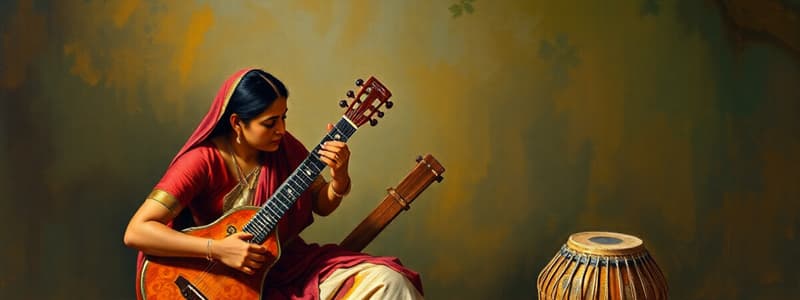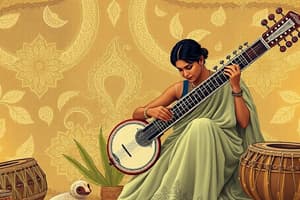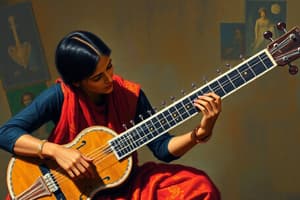Podcast
Questions and Answers
Which combination of instruments and musical elements is traditionally associated with Indian classical music?
Which combination of instruments and musical elements is traditionally associated with Indian classical music?
What distinguishes the dayan from the bayan in a tabla set?
What distinguishes the dayan from the bayan in a tabla set?
What is the significance of the black spot on the drumheads of the tabla?
What is the significance of the black spot on the drumheads of the tabla?
Which of the following inaccurately describes an aspect of Indian classical music?
Which of the following inaccurately describes an aspect of Indian classical music?
Signup and view all the answers
What material is typically used for the covering of a tabla's drumheads?
What material is typically used for the covering of a tabla's drumheads?
Signup and view all the answers
Flashcards
Raga
Raga
A single melody line in Indian classical music.
Drone
Drone
A constant fixed note that supports the melody in Indian music.
Tala
Tala
The rhythmic cycle in which the tabla plays throughout a piece.
Tabla
Tabla
Signup and view all the flashcards
Dayan
Dayan
Signup and view all the flashcards
Study Notes
Indian Classical Music
- Indian classical music has been passed down for over 3,000 years.
- Musical instruments are highly respected, seen as a part of God.
Sitar, Tabla, and Tamboura
- These instruments are a common example of a group of instruments, used in Indian classical music.
- The music often has three parts: raga, a melody line; tala, a rhythm; and drone, a constant fixed note.
Tabla
- The tabla is a pair of drums (dayan and bayan).
- Dayan is often made of wood and bayan of metal.
- Both are covered with goat or cow hide.
- Different parts of the drums create different sounds.
- The tabla plays the tala, a cycle of beats.
- Drumheads have a black spot made of flour and iron filings, which when struck creates a bell-like sound.
Musical Style Variations
- While the basic structure of the music is consistent, the style varies across different regions of India.
Hindustani Music
- Northern India's system of music is often referred to as Hindustani.
- This style has a solo singer who improvises the melody notes (raga).
- Accompanying instruments are important and can include the sitar, tabla, and tambura.
Studying That Suits You
Use AI to generate personalized quizzes and flashcards to suit your learning preferences.
Description
Explore the rich heritage of Indian classical music, which has evolved over 3,000 years. Learn about key instruments like the sitar, tabla, and tamboura, and understand the fundamental components of raga, tala, and drone. Discover regional variations and the significance of each musical element in Hindustani music.




